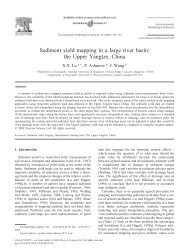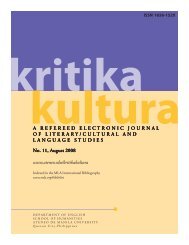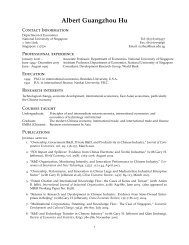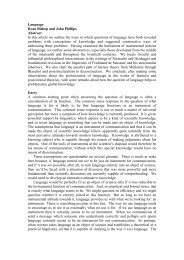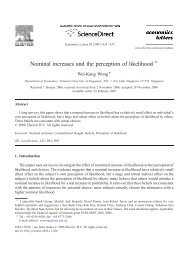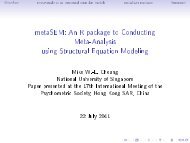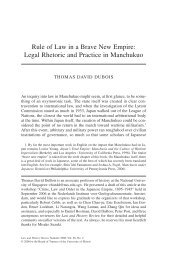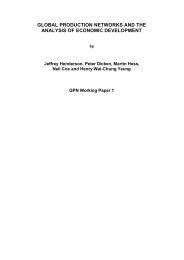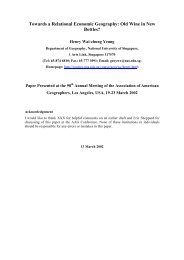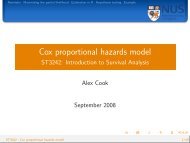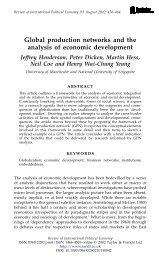The aggregate consumption puzzle in Singapore
The aggregate consumption puzzle in Singapore
The aggregate consumption puzzle in Singapore
You also want an ePaper? Increase the reach of your titles
YUMPU automatically turns print PDFs into web optimized ePapers that Google loves.
574 T. Abeys<strong>in</strong>ghe, K.M. Choy / Journal of Asian Economics 15 (2004) 563–578<br />
0.7<br />
0.6<br />
0.5<br />
0.8<br />
0.6<br />
0.4<br />
0.2<br />
APC<br />
198 198 199 199 200<br />
loan<br />
198 198 199 199 200<br />
22.<br />
20.<br />
17.<br />
15.<br />
0.0<br />
0.0<br />
0.0<br />
Fig. 5. <strong>The</strong> APC and key ratios.<br />
f<strong>in</strong>ancial wealth<br />
198 198 199 199 200<br />
visitor expenditure<br />
198 198 199 199 200<br />
differently, a unitary <strong>in</strong>come elasticity conditional on constant wealth–<strong>in</strong>come, loan–<br />
<strong>in</strong>come, and visitor expenditure–<strong>in</strong>come ratios.<br />
<strong>The</strong> regression results for (10) are shown <strong>in</strong> column (3) of Table 2 (the estimate of the<br />
constant term is not reported). <strong>The</strong> residual-based ADF t-statistic of 4.68 is significant at<br />
the 1% level accord<strong>in</strong>g to the MacK<strong>in</strong>non (1991) critical value; hence, this test renders<br />
strong support for co<strong>in</strong>tegration. For comparison, we show <strong>in</strong> columns (1) and (2)<br />
regressions that either <strong>in</strong>clude the hous<strong>in</strong>g wealth variable or omit the visitor expenditures<br />
variable. <strong>The</strong> <strong>in</strong>significance of the hous<strong>in</strong>g wealth coefficient re<strong>in</strong>forces the earlier<br />
regression f<strong>in</strong>d<strong>in</strong>gs and v<strong>in</strong>dicates our belief that hous<strong>in</strong>g assets <strong>in</strong> S<strong>in</strong>gapore are perceived<br />
to be illiquid. Furthermore, the ADF t-statistics associated with these regressions <strong>in</strong>dicate<br />
that they do not represent co<strong>in</strong>tegrat<strong>in</strong>g relationships.<br />
In order to correct for possible endogeneity and measurement-error biases of the OLS<br />
estimates and their standard errors, we employed the ‘dynamic OLS’ (DOLS) procedure<br />
popularized byStockandWatson(1993)tore-estimate(10)(seeHayashi,2000,pp.654–657).<br />
We set the lead and lag lengths <strong>in</strong> the dynamic regression to four-quarters, correspond<strong>in</strong>g<br />
roughly to the T 1/3 rule, and ran an AR(1) regression on the residuals to compute the long-run<br />
variance. Table 2 shows that the DOLS coefficient estimates on f<strong>in</strong>ancial wealth and loans are<br />
larger than <strong>in</strong> the OLS case and reassur<strong>in</strong>gly, they come with significant corrected t-statistics.<br />
F<strong>in</strong>ally, we used the Johansen (1988) maximum likelihood procedure for further test<strong>in</strong>g<br />
and estimation. <strong>The</strong> trace test, based on a VAR(2) specification for the four variables,<br />
supports the existence of a s<strong>in</strong>gle co<strong>in</strong>tegrat<strong>in</strong>g vector. Further test<strong>in</strong>g shows that the



